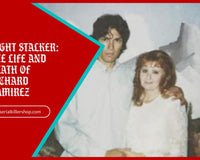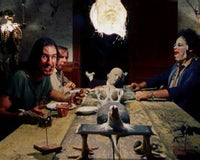
The well-worn monsters of classic horror cinema - the vampires, the zombies, the werewolves have their rightful place in the genre’s history. But, as real life is quick to remind us, the most terrifying monster is man.
Whether in the pages of your local newspaper or on the silver screen, the most heinous deeds of our fellow flesh-and-blood people chill us like no other. They force us to both question the secrets of those around us - the strange old woman down the block, the quiet man behind the grocery counter, the estranged uncle whose name your family speaks only in whispers, and confront the possibilities of what we could do in the grasp of our darkest impulses.
Thomas Harris, author of 1988’s The Silence of the Lambs, understood this, as did Jonathan Demme, director of the book’s Oscar-winning 1991 film adaptation. The film’s Buffalo Bill serial killer has no supernatural powers. He is as much a human as me, as you, as Clarice Starling, the film’s heroine --- and as his very real inspiration, Ed Gein.
The Real Buffalo Bill
Edward Theodore Gein’s early years were harsh but, sadly, unremarkable for their time. Born in 1906 in La Crosse County, Wisconsin, Ed was the younger son of George and Augusta Gein. According to a study of Gein’s life by psychology students at Virginia’s Radford University, George was a violent alcoholic who routinely beat young Ed to the point that his ears rang. Augusta, who chiefly supported the family through her work as a grocer, was a domineering religious fanatic who verbally abused Ed and his older brother, Henry.
Despite this abuse, Ed was deeply devoted to his mother throughout his life. After George Gein died in 1940, this attachment became the source of friction between the Gein brothers, both of whom still lived on the family’s isolated farm in Plainfield, Wisconsin. To Ed’s ire, Henry Gein began to criticize their controlling mother, as well as what he saw as Ed’s overdependence on her.
In May 1944, Henry Gein was found dead in a burning field near the family farm. Though Henry’s body had severe head trauma and no signs of having been damaged by the fire, his death was ruled accidental. Just months after her older son’s death, Augusta Gein suffered the first of a series of strokes. By December 1945, she too had died, leaving Ed the last surviving member of his immediate family.
Ed’s behavior quickly spiraled out of control. Over the next several years, he sneaked into local cemeteries to dig up corpses, including his mother’s. The bodies he exhumed were typically those of middle-aged women. In 1951, another middle-aged woman caught Gein’s eye: the very much alive Mary Hogan, who owned a local tavern and was said to resemble Ed’s mother.
*Quick note: If you want to read more about the real life Buffalo Bill I highly recommend this book. Trust me you won't want to put it down.*
Ed began to frequent the Plainfield bar around the same time that a series of unexplained disappearances began to rock the community. In 1954, Mary Hogan too would disappear. Blood and a .22 caliber shell casing were found on the barroom floor. In November 1957, Bernice Worden, a local shop owner, was also reported missing under similar circumstances. A search of the store found a receipt made out to the day's last customer: Ed Gein.
The next day, police walked through the door of Gein’s farmhouse and into a nightmare. The headless body of Bernice Worden was found suspended upside down, slashed open, and field dressed as a hunter would a deer. The rest of Gein’s house was a shrine to his sick mind, with trophies including skulls on the bedposts, furniture and a lampshade made of human flesh, and masks and a full-body “suit” carefully fashioned from the skin of his victims.
The next day, Gein confessed to killing Mary Hogan and Bernice Worden. A years-long legal battle over Gein’s mental fitness to stand trial ensued. Finally, in 1968, he was found guilty of the murder of Worden. In a second trial, he was found not guilty by reason of insanity, and sentenced to live out the rest of his days in psychiatric custody. In 1984, those days came to end. Ed Gein died of respiratory failure in Mendota Mental Health Institute at the age of 77.

The Myth
Ed Gein had barely been arrested when Hollywood raced to make his horrific fact their fiction. Perhaps the story was too fantastic for any other fate. The Encyclopedia Britannica’s list of just some of the notable big-screen serial killers inspired by Gein includes titular Psycho Norman Bates (1960), Leatherface from The Texas Chainsaw Massacre (1974), and, of course, Buffalo Bill.“Our Billy wasn’t born a criminal,” fellow serial killer Hannibal Lecter (Anthony Hopkins) tells FBI trainee Clarice Starling (Jodie Foster) in The Silence of the Lambs. “He was made one through years of systematic abuse.” Lecter, as proxy for Harris, Demme, and, indeed, us, taps into the horror that Buffalo Bill, born Jame Gumb (Ted Levine), was little more than a product of an uncaring environment, the likes of which any one of us could have found ourselves in with just a simple twist of fate.
Though Buffalo Bill was, in fact, an amalgam of several real life serial killers, the elements of his modus operandi derived from Gein are among the character’s most iconic. Many serial killers keep trophies of their victims; like Gein, Bill made his victims the trophies. Both fashioned their victims’ flesh and bones into mementos, most memorably a full skin “suit” and mask. It is also notable that both Gein and Bill targeted women, though it should be remarked that the unexplained disappearances of two Plainfield men in 1952 are generally attributed to Gein. This speculation notwithstanding, both of Gein’s confirmed victims were women, as are Buffalo Bill’s.
TIME Magazine astutely attributes another memorable, if less obvious, facet of Buffalo Bill’s terrifying persona to Gein: his ramshackle home. “Virtually every messy, creepy, isolated killer's home one sees today on TV and in the movies takes as its model the run-down, detritus-filled Wisconsin farmhouse,” TIME notes. Bill’s home was the stage of two of the movie’s most harrowing scenes: the killer’s infamous “It puts the lotion on its skin” exchange with prisoner Catherine Martin (Brooke Smith), and his final showdown with Starling. The dark, twisted corridors of the serial killer’s home, their inherent foreboding aside, could serve also as a mirror, reflecting the inhabitant’s state of mind.
The Legend
Nearly 60 years after his capture, Ed Gein remains synonymous with some of the worst terrors man can commit. The depravity of his acts has inspired many of cinema’s most memorable serial killers, chief among them Buffalo Bill, just as The Silence of the Lambs continues to inspire horror films. In this way, Ed Gein and, by proxy, Buffalo Bill continue to remind us that the greatest horrors of all are often the ones most like us.
All images via Wikimedia Commons













3 comments
R WM
The Green River Killer, Gary Ridgway, left several of his victims in or near the Green River.
Serial killer Ted Bundy lured many of his victims by appearing to be injured and needing help as Bill does with the chair and the van.
Bundy helped catch Ridgway from prison by suggesting the authorities watch the bodies because the killer would come back for necrophilia.
Jack Crawford seems to be based on John E. Douglas, the FBI agent who developed psychological profiling in the FBI (see Wikipedia page and Mindhunter series). Douglas interviewed Bundy, Ridgway, and several other serial killers.
Tori Snider
wow. wack.
Michael Z Archangel
You left out the part of sexual abuse. Having experienced this mental abnormality among close family relatives and associates. The abused will almost never admit the abuse. Shame, fear , intimidation all are mitigating factors. Even love for the abuser. As is common among those suffering from schizophrenia . And multiple personalities. Quite possible the entire family was sexually abused in one form or another. It takes years if never for the abused to open up due to inability to trust under such heinous conditions.